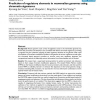5948 search results - page 1179 / 1190 » Computing Robust Counter-Strategies |
BMCBI
2010
14 years 11 months ago
2010
Background: Analyzing interaction networks for functional characterization poses significant challenges arising from the noisy, incomplete, and generic nature of both the interact...
BMCBI
2010
14 years 11 months ago
2010
Background: Human Immunodeficiency Virus type 1 (HIV-1), the causative agent of Acquired Immune Deficiency Syndrome (AIDS), exhibits very high genetic diversity with different var...
90
Voted
BMCBI
2008
14 years 11 months ago
2008
Background: Recent genomic scale survey of epigenetic states in the mammalian genomes has shown that promoters and enhancers are correlated with distinct chromatin signatures, pro...
BMCBI
2007
14 years 11 months ago
2007
Background: Knowing which proteins exist in a certain organism or cell type and how these proteins interact with each other are necessary for the understanding of biological proce...
BMCBI
2008
14 years 11 months ago
2008
Background: Amino acid sequence probability distributions, or profiles, have been used successfully to predict secondary structure and local structure in proteins. Profile models ...

